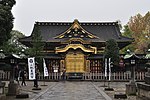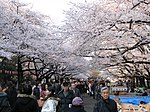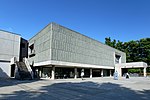Ueno Zoo Monorail

The Ueno Zoo Monorail Line (東京都交通局上野懸垂線, Tōkyō-to Kōtsū-kyoku Ueno Kensui-sen) is a 0.3 km (0.19 mi) long suspended railway operated by the Tokyo Metropolitan Bureau of Transportation (Toei). It lies within the Ueno Zoo in Taitō, Tokyo, Japan. The monorail is similar to the Wuppertal Schwebebahn, but has rubber tires rather than steel wheels. Many of the parts manufactured for the monorail were off-the-shelf. The first monorail in the nation (and the first zoo monorail in the world), it has two stations, single track, and operates at 600 V DC. The line began operating on December 17, 1957, was suspended during 2001–2002, and has been suspended since October 31, 2019, with the operator citing the high costs of replacing the aging trains. Being located inside the zoo, it only operated on days when the zoo was open, and between 9:40 a.m. and 4:30 p.m., with departures scheduled every seven minutes. The fare for the 90-second trip was 150 yen.
Excerpt from the Wikipedia article Ueno Zoo Monorail (License: CC BY-SA 3.0, Authors, Images).Ueno Zoo Monorail
Dobutsuen Dori, Taito
Geographical coordinates (GPS) Address Phone number Nearby Places Show on map
Geographical coordinates (GPS)
| Latitude | Longitude |
|---|---|
| N 35.714430555556 ° | E 139.77069444444 ° |
Address
恩賜上野動物園(西園)
Dobutsuen Dori
110-0007 Taito
Japan
Open on Google Maps











